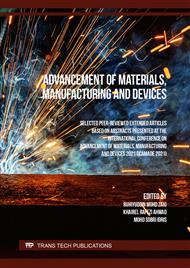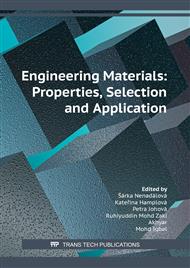[1]
Terzioğlu, P., Öğüt, H., & Kalemtaş, A. (2018). Natural calcium phosphates from fish bones and their potential biomedical applications. Materials Science and Engineering: C, 91, 899-911.
DOI: 10.1016/j.msec.2018.06.010
Google Scholar
[2]
Toppe, J., Albrektsen, S., Hope, B., & Aksnes, A. (2007). Chemical composition, mineral content and amino acid and lipid profiles in bones from various fish species. Comparative Biochemistry and Physiology Part B: Biochemistry and Molecular Biology, 146(3), 395-401.
DOI: 10.1016/j.cbpb.2006.11.020
Google Scholar
[3]
Boutinguiza, M., Pou, J., Comesaña, R., Lusquiños, F., De Carlos, A., & León, B. (2012). Biological hydroxyapatite obtained from fish bones. Materials Science and Engineering: C, 32(3), 478-486.
DOI: 10.1016/j.msec.2011.11.021
Google Scholar
[4]
Bee, S. L., & Hamid, Z. A. (2020). Hydroxyapatite derived from food industry bio-wastes: Syntheses, properties and its potential multifunctional applications. Ceramics International, 46(11), 17149-17175.
DOI: 10.1016/j.ceramint.2020.04.103
Google Scholar
[5]
Nam, P. V., Van Hoa, N., & Trung, T. S. (2019). Properties of hydroxyapatites prepared from different fish bones: A comparative study. Ceramics International, 45(16), 20141-20147.
DOI: 10.1016/j.ceramint.2019.06.280
Google Scholar
[6]
Rajesh, R., Hariharasubramanian, A., & Ravichandran, Y. D. (2012). Chicken bone as a bioresource for the bioceramic (hydroxyapatite). Phosphorus, Sulfur, and Silicon and the Related Elements, 187(8), 914-925.
DOI: 10.1080/10426507.2011.650806
Google Scholar
[7]
Bee, S. L., & Hamid, Z. A. (2019). Characterization of chicken bone waste-derived hydroxyapatite and its functionality on chitosan membrane for guided bone regeneration. Composites Part B: Engineering, 163, 562-573.
DOI: 10.1016/j.compositesb.2019.01.036
Google Scholar
[8]
Ayatollahi, M. R., Yahya, M. Y., Shirazi, H. A., & Hassan, S. A. (2015). Mechanical and tribological properties of hydroxyapatite nanoparticles extracted from natural bovine bone and the bone cement developed by nano-sized bovine hydroxyapatite filler. Ceramics International, 41(9), 10818-10827.
DOI: 10.1016/j.ceramint.2015.05.021
Google Scholar
[9]
Zhu, Q., Ablikim, Z., Chen, T., Cai, Q., Xia, J., Jiang, D., & Wang, S. (2017). The preparation and characterization of HA/β-TCP biphasic ceramics from fish bones. Ceramics International, 43(15), 12213-12220.
DOI: 10.1016/j.ceramint.2017.06.082
Google Scholar
[10]
Khiri, M.Z.A., Matori, K.A., Zaid, M.H.M., Abdullah, C.A.C., Zainuddin, N., Alibe, I.M., Rahman, N.A.A., Wahab, S.A.A., Azman, A.Z.K. and Effendy, N. (2019). Crystallization behavior of low-cost biphasic hydroxyapatite/β-tricalcium phosphate ceramic at high sintering temperatures derived from high potential calcium waste sources. Results in Physics, 12, 638-644.
DOI: 10.1016/j.rinp.2018.12.025
Google Scholar
[11]
Lee, S. J., Yoon, Y. S., Lee, M. H., & Oh, N. S. (2007). Highly sinterable β-tricalcium phosphate synthesized from eggshells. Materials Letters, 61(6), 1279-1282.
DOI: 10.1016/j.matlet.2006.07.008
Google Scholar
[12]
Barakat, N. A., Khil, M. S., Omran, A. M., Sheikh, F. A., & Kim, H. Y. (2009). Extraction of pure natural hydroxyapatite from the bovine bones bio waste by three different methods. Journal of materials processing technology, 209(7), 3408-3415.
DOI: 10.1016/j.jmatprotec.2008.07.040
Google Scholar
[13]
Giraldo-Betancur, A.L., Espinosa-Arbelaez, D.G., del Real-López, A., Millan-Malo, B.M., Rivera-Muñoz, E.M., Gutierrez-Cortez, E., Pineda-Gomez, P., Jimenez-Sandoval, S. and Rodriguez-García, M.E. (2013). Comparison of physicochemical properties of bio and commercial hydroxyapatite. Current Applied Physics, 13(7), 1383-1390.
DOI: 10.1016/j.cap.2013.04.019
Google Scholar
[14]
Pal, A., Paul, S., Choudhury, A. R., Balla, V. K., Das, M., & Sinha, A. (2017). Synthesis of hydroxyapatite from Lates calcarifer fish bone for biomedical applications. Materials Letters, 203, 89-92.
DOI: 10.1016/j.matlet.2017.05.103
Google Scholar
[15]
Benataya, K., Lakrat, M., Elansari, L. L., & Mejdoubi, E. (2020). Synthesis of B-type carbonated hydroxyapatite by a new dissolution-precipitation method. Materials Today: Proceedings, 31, S83-S88.
DOI: 10.1016/j.matpr.2020.06.100
Google Scholar
[16]
Kumar, S., Gautam, C., Chauhan, B. S., Srikrishna, S., Yadav, R. S., & Rai, S. B. (2020). Enhanced mechanical properties and hydrophilic behavior of magnesium oxide added hydroxyapatite nanocomposite: A bone substitute material for load bearing applications. Ceramics International, 46(10), 16235-16248.
DOI: 10.1016/j.ceramint.2020.03.180
Google Scholar
[17]
Yokota, T., Ito, R., Shimizu, Y., Honda, M., & Aizawa, M. (2017). Fabrication of sodium-substituted hydroxyapatite ceramics via ultrasonic spray-pyrolysis route and their material properties. Key Engineering Materials, 758, 166-171.
DOI: 10.4028/www.scientific.net/kem.758.166
Google Scholar
[18]
Bulina, N. V., Chaikina, M. V., Prosanov, I. Y., & Dudina, D.V. (2020). Strontium and silicate co-substituted hydroxyapatite: Mechanochemical synthesis and structural characterization. Materials Science and Engineering: B, 262, 114719.
DOI: 10.1016/j.mseb.2020.114719
Google Scholar
[19]
Beaufils, S., Rouillon, T., Millet, P., Le Bideau, J., Weiss, P., Chopart, J. P., & Daltin, A. L. (2019). Synthesis of calcium-deficient hydroxyapatite nanowires and nanotubes performed by template-assisted electrodeposition. Materials Science and Engineering: C, 98, 333-346.
DOI: 10.1016/j.msec.2018.12.071
Google Scholar



